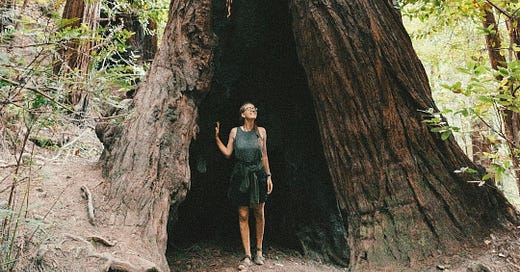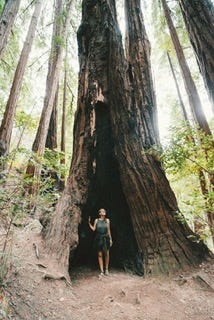Death and destruction can be hard to witness. That’s true whether it’s affecting the structure of the forest, the heart of a city, or the pillars of a society. But it’s a natural part of life.
On Inauguration Day, a day I mourn what might have been and fear what’s to come, I turn to nature for a reminder that life carries on even when something precious dies.
As a forest scientist, I focused for many years on studying decay—or, as we call it, decomposition. Much as a life force combines molecules into cells and cells into living, vibrating tissue, death de-composes that tissue back into cells and molecules.
Working with decaying leaves and logs reminded me of every living being’s eventual fate. The worms really do go in.
When I monitored the carbon cycle in the forests of southern China while working on a master’s degree in forestry, the leaves decomposed in about a year—mostly back into airborne carbon dioxide. That’s typical for leaves in nature.
Leaves in a compost pile can decay within four months, under the right conditions. Warm temperatures, occasional stirring and regular watering speeds the process along.
When leaves unravel, whether in nature or in a compost pile, some once-living material converts into a natural fertilizer high in carbon, nitrogen and other nutrients. That’s why compost of all kinds boosts plant growth.
The dead trees I researched for my doctorate degree endured far longer on the landscape. In the mountains of Colorado, I applied tree-ring science to estimate the timing of their death. Portions of those dead logs remained identifiable and roughly datable up to 80 years after they fell.
In the late stages of decay, they’d crumble into a color and texture almost indistinguishable from the soil below them. That’s a sign of tree carbon converting into soil carbon. This nourishes life and improves the soil’s ability to hold water and share it with plants.
Decaying logs support life in other ways, too. On their long road to decomposition, the bulky pieces of dead wood serve as habitat, shade, anti-erosion barriers, food for wildlife, and a sponge to store rainwater.
Of course, if dry conditions linger too long, logs can turn into tinder. Some forests, such as aspen and lodgepole pine, require wildfires to regenerate. For many other forests, fire is a naturally recurring process.
Tree-ring science has shown many western forests evolved with surface fires occurring every decade or two. Fires would burn leaves and kill small trees, leaving the larger ones to survive and often thrive. California’s redwood trees grew massive despite the recurring fires.
Redwoods may evade the Grim Reaper for thousands of years, enduring dozens if not hundreds of wildfires along the way. Even after they succumb, their wood endures, often for centuries. Visiting a redwood forest is a great way to disappear into the landscape for a few hours.
These days, it’s harder to see this for ourselves, as about 95 percent of California’s coastal redwood forests have disappeared since the mid-1800s. The rush for gold turned into a rush for old growth. Incoming humans sought decay-resistant redwood lumber for construction of homes, decks and other structures, and chose to build some of those where redwoods once stood tall.
Some of the remaining ancient redwood trees start decaying while they’re still alive.
You can walk into the middle of standing redwood trees in California’s Muir Woods National Monument near San Francisco. The blackened interior of one I entered could have fit a circle of 10 or more seated people. I could stretch my arms up into the cavity looming above without touching the top.
Many of this tree’s neighbors had a similar look, with an empty space in the trunk’s core. The interiors had certainly decomposed—in the dramatic way provoked by fires. Yet the trees survived.
Like everything else, they too will eventually die and decay, leaving little more than imprints on the landscape. For now, some endure to grace California’s coast.
With them in mind, there’s still room for hope that our democratic government could come to parallel long-lived redwoods.
Even when a tree or a system’s faces trial by fire, it can potentially recover to thrive for centuries to come.
* * *
On your next walk in a natural forest, pause on the trail and look around. You might be surprised at how many dead and decaying logs you see. Our mind tends to overlook them unless they’re blocking our paths. If you can, inspect a few of the fallen logs for signs they’re serving as animal habitat or food for termites and worms and nourishment for fungi. Mushrooms often sprout in decaying wood. Revel in the concept that trees continue to support life around them even after their own demise.
* * *
Notes and Resources
Osterkamp, W. R., Toy, T. J., Lenart, M. T. (2006) Development of partial rock veneers by root throw in a subalpine setting. Earth Surface Processes and Landforms, 31 (1) 1-14 doi:10.1002/esp.1222
Lenart, Melanie T., 2003. A comparative study of soil disturbance from uprooted trees, and pit and mound decay, in Puerto Rico and Colorado. Ph.D. Dissertation, School of Natural Resources and the Environment, University of Arizona, 175 pp.
Norman, Steve, 2007, Where the Redwoods Are, in Coast Redwood Ecology and Management, US Forest Service.
Also see information from Save the Redwoods League.





